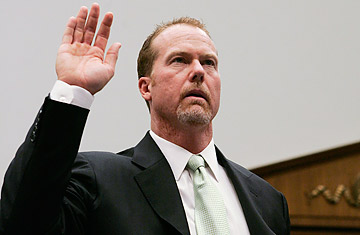
Former St. Louis Cardinal Mark McGwire is sworn in during a Capitol Hill session investigating steroid use in Major League Baseball, March 17, 2005
The saddest part about Mark McGwire's insistence that he was naturally "given the gift to hit home runs" — even as he copped Jan. 11 to a near decade's worth of steroid use — is that it might just be true. He did, after all, smash the single-season home-run record for rookies with 49 long balls in 1987 — two years before, he says now, he first tried doping. Could he have edged out Sammy Sosa to crush Roger Maris' 37-year-old home-run record in 1998 — knocking 70 balls out of the park — even without juicing? Fans will never know.
Physical performance enhancers have long been with us. The ancient Greeks popped sesame seeds and hallucinogenic mushrooms before athletics contests; Roman gladiators used stimulants to get an edge. Today's drug of choice, anabolic steroids — anabolic from the Greek verb meaning to put on or add — are synthetic compounds of such hormones as testosterone, known to build muscle and boost strength. Anabolic steroids cobble together simple materials from the gut and blood into more complex, living tissue, helping athletes bulk up — fast.
Scientists began looking for what we now know as testosterone as early as the 1840s, but research was hampered by pervasive skepticism that such a substance existed. In 1926 scientists finally first documented the existence of a male sex hormone in a bull's testicles, and by 1935 they had chemically synthesized testosterone.
Rumors persist that subsequent work on steroids occurred in Nazi Germany; doctors reportedly dosed troops with testosterone to give them an aggressive edge on the battlefield, and even Hitler himself was injected with steroids. But the science of that era is so shrouded in secrecy that it's Maryland physician — and gym rat — John Ziegler who is usually given credit for first creating anabolic steroids. After reportedly learning that Soviet weightlifters at the 1954 World Weightlifting Championships in Vienna were getting a boost from testosterone, he returned home eager to give U.S. lifters a similar up. But Ziegler's early attempts at dosing left athletes complaining of illness and with little improvement in strength.
After refining his experiments, Ziegler hit upon the first anabolic steroid, known as methandrostenolone and marketed in 1958 by Ciba Pharmaceuticals as Dianabol. But there was already a dark side. Ziegler's test subjects quickly started abusing the drugs and developed such side effects as swollen prostates or shrunken testicles — an outcome that would prompt the doctor to condemn his own creation before his death in 1983. Nonetheless, by the early 1960s pharmaceutical companies had developed nearly a dozen rival steroids, which quickly gained popularity off-label with athletes. In 1976, the International Olympic Committee became the first sports group to ban steroids.
Over the ensuing years, a rash of doping scandals in the sports world — from cycling to track and field — prompted authorities to crack down harder on drug use. But in many quarters, baseball was believed to be largely immune. In April 1988 the Los Angeles Times reported that America's pastime remained "essentially steroid-free." While Washington Post sportswriter Thomas Boswell would call Oakland slugger Jose Canseco "the most conspicuous example of a player who has made himself great with steroids" later that year, Canseco shrugged off the charge; he went on to be named American League MVP. (He would later admit to doping from as early as 1985, saying steroids in late-1980s and 1990s baseball were as common "as a cup of coffee.")
Steroids were added to baseball's banned-substance roster in 1991, but no testing was mandated. Fans and officials largely turned a blind eye, even as players' bodies swelled along with their achievements. In 1999, even after McGwire had copped to taking androstenedione — or "andro," an over-the-counter precursor to testosterone later banned by the FDA — Senator Edward Kennedy called the slugger and his rival Sosa the "home-run kings for working families in America." A year later, the suggestion in the New York Times that up to 40% of major league players had taken steroids was largely met with crickets.
Eventually, however, the critics started to gain ground. Baseball traditionalists charged that doping undercut the sport's most storied records. The medical community, meanwhile, pointed to serious side effects: male breast development, coronary heart disease, susceptibility to injury and the mood swings known as 'roid rage, among others. The rising number of teens emulating their idols by doping provided more cause for concern.
In 2002 the major league players and managers agreed to begin limited, anonymous testing for steroids. Two years later President George W. Bush took the unprecedented step of condemning steroids in his State of the Union address, saying the use of the "dangerous" drugs in baseball, among other sports, "sends the wrong message — that there are shortcuts to accomplishments, and that performance is more important than character." That same year, standards grew tougher and major leaguers submitted to their first mandatory steroid tests. Under the penalties first introduced for doping in 2005, 12 players were suspended for 10 days each.
Two years later, former U.S. Senator George Mitchell capped his 21-month investigation into steroids in baseball — begun at Commissioner Bud Selig's request — with the infamous Mitchell Report, which called out 89 major league players for allegedly using steroids.
Testing has since helped clean up the sport. But it still struggles to shrug off the stain of doping. "I wish I had never played during the steroid era," McGwire said in his confession. He may not be alone.
